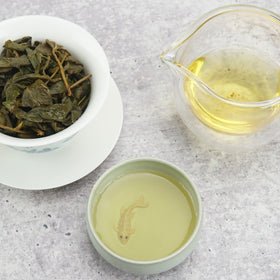
Tea ware at Metropolitan Museum of Art
It was a great way to kick off 2020 for us: a visit to the Metropolitan Museum of Art in New York city where some priceless tea articles from Japan were on display as part of the exhibition "Kyoto: Capital of Artistic Imagination."
After a busy holiday season, for which we are enormously grateful to you our customers, a trip to NYC was nice way for the family to come together and explore the city. While we saw many interesting things and ate some fantastic food, the trip to the MET was pièce de rèsistance.
While it rained on a usually warm day in January we were happy to be lost in the rooms and hallways of the museum that contained cultural treasures from around the world. But for me, as I said, the Kyoto exhibit which included Japanese tea ceremony articles was especially interesting.
Hope you will enjoy the pictures of the artifacts below. Please note they were all taken through glass enclosures so the quality may be somewhat compromised.


This tea bowl above is by potter Eiraku Hozen (1795-1854). According to the description, Hozen was a prominent ceramist during the late Edo period, a time when imperial temples and diamyo households started to commission wares from Kyoto potters. Brightly colored and embellished with glittering gold and silver details, the tea bowl is decorated with motifs of the rising sun and auspicious cranes in celebration of the New Year. (Perfect for this time!). With this decoration, Hozen revived the style of Nonomura Ninsei, the most well-known potter of late seventeenth-century Kyoto.



This tea jar from Meiji period (1853-1909) was most intriguing because it was said to be decorated in "Cochin (Kochi) style". Cochin is an area in the southern state of Kerala in India that I am very familiar with. The description at the museum did not say much other than that it was "stoneware with relief decoration and polychrome glazes; imitation gold lacquer repair (kintsugi), pewter cover. (Kyoto ware, Eiraku type)." Upon researching Kochi-ware is said to be a type of Japanese pottery based on Cochin ware originally from southern China, and that the English word "Cochin" derives from the Chinese word Jiāozhǐ (交趾) used to describe various parts of the south including Vietnam.
Cochin I knew came from the word Kochi which is how the local refer to the city of Kochi. The English called in Cochin. Interestingly, I found that that Kochi was a protectorate of the Ming China briefly in the early fifteenth-century. Not surprising because Kochi was a very important stop in the trade route between China and the Arabian world and continued to be as European traders emerged in the scene.
Anyways, the colors and the decorations on that tea jar did recall to me the florid temple sculptures of Kerala.



The bowl above with "hare's fur glaze" was from Chinese Song dynasty period (960-1279). Now that is something you don't get to see everyday! Although this is not from Japan, this "Tenmoku" tea bowl was part of the exhibition perhaps because it was during this period that the practice of drinking tea - powdered tea to be specific - was transferred from China to Japan.
Finally, there were other interesting tea articles we found in other parts of the museum. The one below was collaboration between Mughal India around 1700 and Germany around 1720. Tea may not have officially been present in India during this time but it seems they were aware of this new European habit.


The above is a French teapot made from "hard-paste porcelain, silver, ivory" dating back to 1832-34. The description noted that the teapot was produced as a single item rather than as part of a set. Its silver and ivory handle and its small scale suggest it was intended as a luxury object rather than a functional pot. The Sevres factory archives indicate that this teapot was purchased by Queen Marie-Amelie in 1837.
To view all these priceless tea ware at MET at the start of the year we believe is an auspicious start. May 2020 bring all of us more happiness, beauty and great tea!


Leave a comment